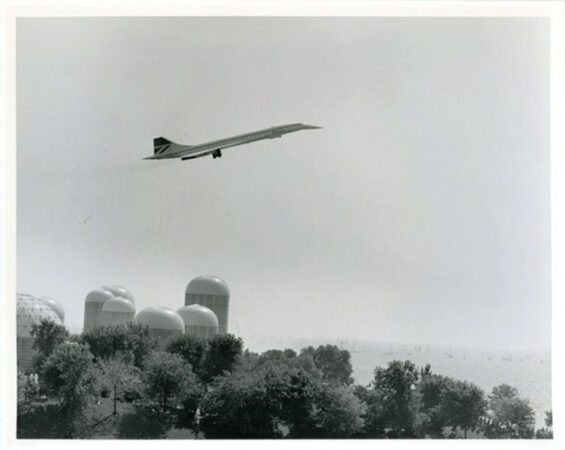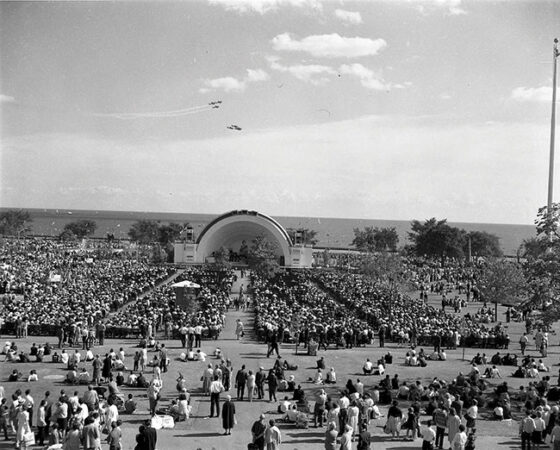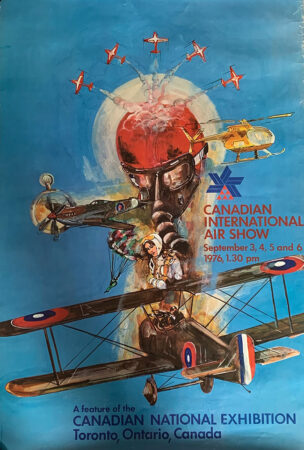
Features
Airports
Flypast, Canadian International Air Show turns 75
The Canadian International Air Show turns 75. Wings gets a peak behind the curtain of North America’s longest running air show.
July 30, 2024 By David Carr
 The Italian Air Force Frecce Tricolori demonstration team was a highlight of the 1985 Canadian International Air Show in Toronto.
PHOTO: department of national defence
The Italian Air Force Frecce Tricolori demonstration team was a highlight of the 1985 Canadian International Air Show in Toronto.
PHOTO: department of national defence August is winding down. In a couple of weeks, the summer rhythm of the Toronto waterfront will be drowned out by the pulsating roar of jet engines. The air show is back in town. The Canadian International Air Show (CIAS) is North America’s longest running, and one of the continent’s most unique. For 75 years, the glorious history of military and civilian aviation has unfolded above Lake Ontario.
The CIAS is a three hour and 40 minute spectacle of jets, aerobatics and precision flying that shares air space with Toronto’s Pearson International Airport (YYZ), Canada’s busiest, and Billy Bishop Toronto City Centre (YTZ), home to Porter Airlines, a CIAS partner.
“At most shows, everything is at one airport and is taking place at one spot. We are at two different airports and the show is held elsewhere, so we are moving a lot of parts and a lot of people,” says Lori Duthie, the air show’s Executive Director. “Coordinating with those two airports is probably our biggest challenge. We work with all the airlines and especially with the island airport to shut down air space.”
But not entirely. To open a window for some air traffic on the waterfront, the show is divided into three blocks, two jet blocks where YTZ is shutdown and a middle ‘civilian block’ filled with smaller airplanes, helicopters and acrobatic teams that the airport can work around. “Air shows are an air space management industry,” Duthie points out. “We’d like to even out the program more but that would be wasting a jet block. Which is why we have the big, fast jets at the beginning and the end.”
This year, the fast stuff includes the United States Air Force F-22 Raptor, perennial crowd favourite The Snowbirds, and a return of the popular Royal Air Force (RAF) Red Arrows as part of a four-stop Canadian tour to celebrate the 60th anniversary of the U.K. aerobatic team and to honour the 100th anniversary of the Royal Canadian Air Force (RCAF). To mark their Diamond Anniversary, the Reds are promising maneuvers not seen in over a generation.
Air shows are big business. According to the Canadian Encyclopedia, air show attendance is second only to Major League Baseball as a spectator event in North America. More than 70 million fans visited a professional ball park in 2023. One million thrill seekers are expected to crowd into the ticketed and free viewing areas along a 14-kilometre strip of the waterfront for the three-day air show. Putting the CIAS attendance up there with the Toronto Caribbean Carnival, Pride Weekend and the Santa Claus Parade as one of the city’s top ranked events. Live streaming, viewing the show from pleasure boats around Toronto Harbour and atop condominium rooftops will swell numbers to 1.4 million.
“Most air shows are gated. You drive in and you stay in one spot,” Duthie explains. “One of the unique things about Toronto is it can be enjoyed in different ways. The ticketed area provides an elevated experience where you can meet the pilots. But you can watch for free from so many great vantage points.” Approximately 80 per cent of the prime viewing areas is free access.
Unlike most city events whose planning cycle is year-to-year, the CIAS must plan two and three years in advance. “We work with various militaries, including Canadian, U.S. and British years out to coordinate the right assets for every show,” Duthie says. Even then, there are hiccups. “We normally fill up the civilian side by the end of July because we need to get the paperwork to Transport Canada within a specific time,” Duthie says. “But militaries are still operational. We can be getting changes five to three weeks out on the military side.”
In 2022, when the Snowbirds were forced to cancel weeks before the show after an incident involving one of its Tutor aircraft on take-off in British Columbia. That triggered a mad scramble to book acts to fill a large space in the closing block. “The Snowbirds traditionally close the show. That was a prime spot to fill,” Duthie adds.
- Toronto was one of North America’s first air shows to host the Concorde, seen here in 1982.
- The Vulcan visited CIAS in 1982.
- A massive crowd takes in the 1963 Canadian International Air Show with Lake Ontario serving as its traditional backdrop. Air show organizers today provide a 14 kilometre stretch for viewing, mostly free.
Humble beginnings
Air shows are almost as old as powered flight and began modestly in 1908 as an add-on to the Paris Automobile Show. The inspiration of several French aviation pioneers, including Louis Blériot, who one year later would become the first aviator to cross the English Channel in a heavier-than-air machine, pocketing a £1,000 prize offered by London’s Daily Mail. The world’s first exhibition devoted exclusively to aircraft took place at the Grand-Palais near the Champs-Èlysées.
In 1919, a team of veteran pilots, led by Lieutenant Colonel William Barker, a First World War ace performed daily flyovers in German-built Fokker D.V11 fighters, captured during the war, for the seventh edition of the modern Canadian National Exhibition (CNE). It is thought to be the first aerial formation demonstration in Canada, and showed that enthusiasm for aviation had no bounds for pilot and public alike.
A Toronto air show was taking shape in the years immediately following World War II, including a full-scale show at Downsview Airport in 1946. In the summer of 1947, 16 Avro Lincolns (a version of the Lancaster heavy bomber) of RAF 617 Dambuster Squadron flew over Toronto as part of a North American goodwill tour. One year later, the Toronto Flying Club hosted an air show at Malton Airport (now Pearson) where The Globe and Mail reported that over 80,000 “stormed” the field.
In 1949, the air show was branded as the National Air Show and moved to the Toronto waterfront. The first display was headlined by the RCAF Blue Devils Vampire Jet aerobatic team, forerunners to today’s Snowbirds, who streaked across the lake for their first CIAS performance in 1972. The event was renamed the Canadian International Air Show in 1955, and would soon begin an affiliation with the CNE that made the air show a Labour Day weekend staple and an unofficial end of summer tradition.
Summer is the height of air show season in North America. There are 82 shows between the first day of summer until Labour Day, according to the International Council of Air Shows. But air shows are cost-intense events to host, and many smaller shows became victim of high fuel prices and military budget cuts.
In the early teens, decisions by the United States Air Force (USAF) and United States Navy to temporarily pull the Thunder Birds and Blue Angels jet aerobatic teams for budgetary reasons, and the Federal Aviation Administration (FAA) to bill for air traffic control costs and overtime, produced attendance and cost hardships that many shows were unable to recover from.
NAV Canada coordinated 29 air shows in 2023. It reserves the right to charge for its services, but typically negotiates a sponsorship-in-kind agreement with each show. NAV Canada also waives fees for aircraft arriving internationally for a show.
The CIAS is a not-for-profit, fully funded by sponsorships and ticket sales. A lot of military aircraft performing at the show are free. “We pay 100 per cent for the civilian acts and jet teams such as the Red Arrows and Thunder Birds. They all have performer fees,” Duthie says. The 75th edition of the air show will consume 500,000 litres of fuel, occupy 1,400 hotel rooms, rent 102 vehicles and serve more than 700 boxed meals for a team of 200 enthusiastic volunteers.
Security is another big-ticket item. For its first appearances, the F-22 performed a double act with the Cleveland Air Show, flying back to the U.S. without landing in Canada. In 2007 the Raptor performed remotely and needed heavy security around a hangar at YYZ. This was also the first landing of an F-22 outside of the U.S.
At the CIAS office, tucked inside the CNE administration building, Lori Duthie and a team of volunteers are nailing down the final details of this year’s show. Duthie became Executive Director in 2018 after leaving Air Canada. But the CIAS has been part of the Duthie family DNA since the early 1970s, when her father, Don Duthie, ran the show. (Her grandfather, George, was the CNE’s sports director for over 30 years, beginning in the Depression era.) Lori started as a volunteer when she was 17. “I have never been anywhere on Labour Day weekend except on the waterfront.” Even during Covid when the CNE was shutdown and the air show was live streamed, she insisted on walking the site. “I can’t have a Labour Day weekend when I’m not on the waterfront.”
- Some of the memorable promotional posters of the Canadian International Air Show.
Something for everyone
A successful air show must have something for everyone. Audiences want to see the latest military hardware. They also want to see helicopters, be awed by stunts and loops, precision flying and a nod to aviation’s rich heritage. Duthie and her team have packed variety into a program that typically runs one hour longer than the average summer blockbuster movie.
The CIAS likes to commemorate significant dates in aviation history. In 1959, the F-86 Sabres of the RCAF Golden Helmuts performed to honour the 50th anniversary of powered flight in Canada. In 1979, the first of 10 visits by a British Airways Concorde commemorated the 30th anniversary of the show. The CIAS was one of the first North American displays to showcase the Concorde. In 2010, Lieutenant Colonel Maryse Carmichael, the first female Commanding Officer of The Snowbirds opened the show to mark the centennial of the Royal Canadian Navy and Women in Aviation.
This year, the 75th anniversary of the air show, centenary of the RCAF and diamond anniversary of the Red Arrows converge to mark 235 years of aviation history. “It’s a big year,” Duthie acknowledges. “We are mixing the vintage and modern to show the evolution of the last 75 years.” The show will be bookended by The Snowbirds and Red Arrow jet teams. The teams will rotate opening and closings, giving the Canadian crew a rare opportunity to watch the close along with fans at the premium ticketing areas. In recent years, duo jet demonstration teams have been a signature of the CIAS. In 1986, crowds were spoiled by The Snowbirds, the Italian Air Force Frecce Tricolori and the USAF Thunderbirds.
Between the opening and closing headliners will be the return of the F-22 Raptor, a rare appearance of the Canadian Warplane Heritage Museum’s Lancaster heavy bomber (one of only two that remain flying) and North American B-25 Mitchell medium bomber flying in formation, crowd favourite Kyle Fowler and his Long EZ and the CF-18 demonstrator team sporting a commemorative paint job paying tribute to the 100th anniversary of the RCAF.
What of the next 25 years? Duthie says the industry has rebounded from Covid and military budget cuts. Skills shortages could pose a greater threat to the sustainability of air shows. “Air shows are a nice to have,” she says. “They are not a need to have.”
But air shows can also be a part of the solution. In the barnstorming days of the Roaring Twenties, enlisted mechanics were on the ground teaching students how to repair a Liberty L-12 airplane engine. Fast forward more than 100 years and the CIAS has created a Science Technology Engineering and Math (STEM) area to get a new generation excited about aviation.
STEM is located in a free access section of the air show that is filled with a CF-18 cockpit mock-up, Cadet glider and booths by aerospace colleges and companies like NAV Canada. “Air shows are not going to exist unless we can help to fix the skills shortage. Our motto is always to honour aviation’s past and inspire its future. The air show inspires. STEM helps a new generation think about what they saw on the way home.”
- Canadian photojournalist Boris Spremo captured The Snowbirds’ flypast of the CN Tower.
- The awe inspiring AVRO Vulcan rumbles above the former bandshell housed at the Canadian National Exhibition grounds.
As it does every year, the CIAS will present hours of seamless jet performances, precision flying displays and edge of the seat aerobatics. Behind the scenes it is a different story, where every second counts. At the 2023 show, a person jumping off a boat caused the cancellation of an F-16 demonstration. “It’s never the same thing twice,” Duthie says, “but there is always something where you need to be able to pivot.” Jet performances are locked in. Civilian performers, like their military counterparts have memorized routines they won’t break from, but there is always flexibility to add extra fly-bys if the fuel tanks aren’t running dry. “Air show performers are amazing,” Duthie says. “What happens in the air is the easy part because we have the best of the best. And we have great air bosses. It is what happens on the ground that will always be the challenge.” Duthie is the CIAS’s sole staff member, but it is more than a one woman show. The annual event is supported by 20 year-round volunteer managers and 200 game-day volunteers who keep the show firing on all cylinders. “We are very much volunteer driven,” she says. “They are amazing and are the crux of the show.”
In recent years, the team has enhanced the viewing experience. Attendees no longer have to strain an ear to listen to muffled play-by-play over a tinny sound system. Free audio on the CIAS website provides clear, real-time narration of the action over the lake and is packed with extras such as a pilot’s back story and how they got into aviation. Live stream has also extended the reach of the air show. Last year, the event was watched in 40 countries.
The 75th anniversary edition of the Canadian International Air Show will echo with the sounds of air shows past. Barnstorming performances of aerobatic teams, the precision flying of The Snowbirds and the roar of jets such as the RAF Vulcan, Lockheed SR-71 Blackbird spy plane and F-35. When asked what would be her dream get for a future show, Duthie, herself a pilot, was quick with answer: A final visit by the F-15 Eagle before it is retired and an elusive appearance by the B-52 bomber.
The last Stratofortress was delivered to the USAF in 1962. The air force is undergoing an extensive overhaul of 76 B-52s including new Rolls Royce engines and modernized radar, extending the life of the aircraft to at least 2060, when it will have served for over 100 years. There’s always next year.
HIGHLIGHTS of the 2024 Canadian international show
- CAF The nine-plane formation of The Snowbirds return, flying the venerable Canadair CT-114 Tutor.
- RAF The Red Arrows are making their third appearance ever at CIAS.
- Mk. X The Avro Lancaster and B-25 Mitchell will fly in formation.
- F-22 The USAF F-22 Raptor Demonstration team.
- CF-18 The CF-18 Hornet demo team out of Baggotville.
- C-47 The C-47 Dakota from CWHM flies on Saturday.
- BO 105 Scott Urschel inverting his Airbus BO 105 helicopter.
- EZ Kyle Fowler is back with his unique Long EZ.
- P-12 Trevor Rafferty and his Pitts 12 fly in from Hamilton.







